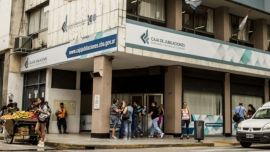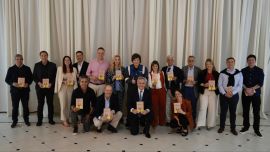Sending a clear message to the markets and beyond with its declaration it will seek a fiscal deficit of zero next year, the Mauricio Macri administration has decided to put an end to its path of gradualism and tighten Argentina’s belt even further.
But that won’t come without a cost, experts warn, with the economy now expected to contract up to two percent this year accompanied by a growing inflation rate now tipped to hit 40 percent.
The government decided this week to impose tariffs on exporters as a way to balance the budget by next year – a year earlier than initially planned – following the collapse of the peso and concerns from investors regarding Macri’s administration capacity to finance itself.
As the plan came together, a rush visit to Washington for talks with the International Monetary Fund (IMF) was pulled together. Economy Minister Nicolás Dujovne detailed the austerity measures to IMF head Christine Lagarde, seeking approval for advanced cash disbursements f rom t he US$50 -bi l l ion stand-by loan sealed back in June.
Nevertheless, that might not be enough.
CONCERNS
Markets are still worried about the combination of further austerity measures and insufficient pro-growth structural reforms.
Some experts warn these could affect Argentina’s domestic corporate sector and lead to drop in demand, aggravating the impact of the currency crisis on the country’s ability to raise capital and meet debt obligations.
“There’s a lack of trust, that’s the gist of it,” Alejandro Bianchi, the head of investments at Invertir Online, told the Times. “Investors and the exchange market didn’t find the government announcements were enough. That adds up, with bad foreign conditions, [and] we stopped having as positive an outlook as the rest of the emerging countries.”
Economists in the monthly survey published by the Central Bank see the economy contracting 1.9 percent this year, compared with the previous forecast of a 0.3 percent contraction. Inflation is expected to end the year at 40.3 percent, up from the 31.8 percent prediction in July.
At the same time, the Argentine peso – the worst-performing currency in emerging markets so far – is predicted to finish the year at 41.90 per dollar, markedly weaker than the 30.50 seen in July’s survey.
In all, the peso is down more than 52 percent against the dollar so far this year.
TOOLS
“This isn’t a terminal situation though, it’s caused by a balance of payments crisis,” economist Fausto Spotorno, the head of the Economic Studies Centre at Orlando Ferreres consultancy firm, told the Times.
“The government doesn’t have many tools to control it, so it’s limited to raising the interest rate and selling currency in the market.
“The Central Bank felt short on its foreign currency reserves. It wasn’t able to accumulate as much as needed to deal with this crisis.
“If it had more, it would have been able to avoid it,” he added.
Seeking to avoid a further devaluation, the monetary authority has been selling reserves almost daily, having lost US$11.83 billion since June 22, when the first funds from the IMF arrived. Meanwhile, interest rates were hiked to 60 percent, the highest level in the world.
For Ariel Setton, an economist with the University of Buenos Aires (UBA), the Mauricio Macri administration has been solely focused on the fiscal front, thinking the solution comes from reducing public expenditure.
That’s not the best approach, he argues.
“The Argentine economy should stop seeing expenditure as the only instrument of monetary policy.
“Export duties had to be reinstated, so the extraordinary benefits that the farming sector has can be shared with the state, in order to maintain public policies for the neediest,” Setton told the Times.
ROUGH YEAR
The events of the last few weeks on the economic front has led experts to predict a difficult year lies ahead for the country’s economy. Predictions of strong growth and lower inflation at the beginning of the year are now null and void.
While government officials have admitted to mistakes, the country experienced a record drought in 2018, chalking one percentage point off GDP according to government estimations, while the rise of US interest rates back in April lead to an emerging market sell-off.
August was the peso’s worst month since the country’s historic economic crisis in 2001, with consultancy firms across-the-board now predicting an economic drop this year and likely in 2019 too.
“The exchange rate stopped being cheap, any further devaluation shouldn’t last long as we are at an equilibrium. Exporters will push for further sales, while importers will reduce their purchases and replace with local goods. But it will take time for that to happen,” Spotorno said.
The crisis is beginning to bite. The industrial sector dropped 5.7 percent in July, following an 8.1 percent drop in June (both compared to the same month last year), according to the INDEC national statistics bureau. While the devaluation helped exporters, it wasn’t enough to compensate for the drop in the domestic market – leading to lay-offs or voluntary retirements.
So far this year, 154 lay-offs or suspensions have been registered per day, according to a report by the Political Economy Centre (CEPA). In the first seven months of the year alone, 32,794 people were laid off or experienced a reduction in their work-day hours. Of those, 20,622 were privatewsector workers, compared to 12,532 state workers.
“The government didn’t seek to solve the grassroots problems of the economy. It only created expectations that everything could be solved with monetary policy and lower expenditure,” Setton argues. “As the economy was focused on agriculture and services, industry has experienced a dramatic fall.”


























Comments